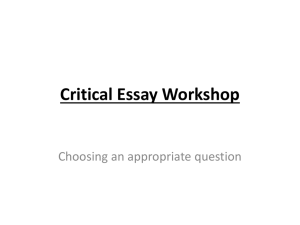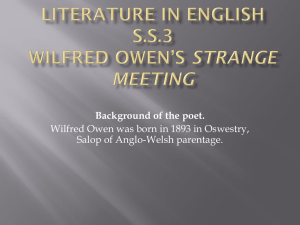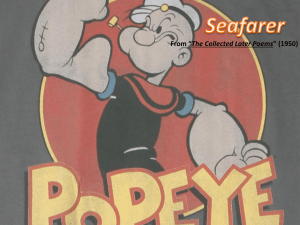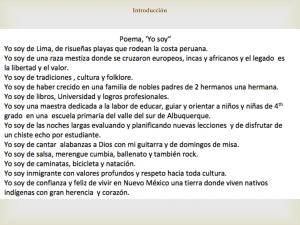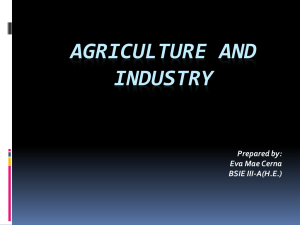December 11_ 2012--Haikus
advertisement
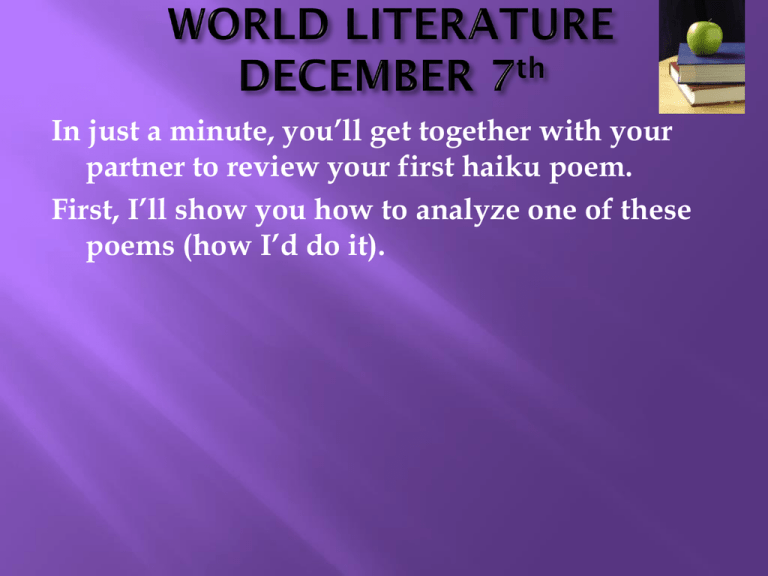
In just a minute, you’ll get together with your partner to review your first haiku poem. First, I’ll show you how to analyze one of these poems (how I’d do it). Spring rains weaving Eccentric brocades Across the face of the water– Will they dye all the hills green? 1) Initial thoughts/questions/comments: This seems to be a poem about nature and about the impact of spring. I notice this because it specifically mentions spring rains and questions what impact these rains will have. It seems to suggest that spring is beautiful and creates life. Spring rains weaving Eccentric brocades Across the face of the water– Will they dye all the hills green? 2) Dominant mood: I believe that the mood is that of wonder, appreciation and peace. The idea of growing new life creates a sense of wonder within me, as well as a sense of appreciation for the beauty that nature is able to create. Picturing the beauty of nature also brings me a sort of peace because it’s so distant from the stress and worry of human life. Spring rains weaving Eccentric brocades Across the face of the water– Will they dye all the hills green? 3) Image that stands out: I picture “dye all the hills green” the most powerfully. I imagine a rainy, cloudy day where as far as the eye can see, new grass and new life is just beginning to form after brown, lifeless land. I associate this with newness, life, and celebration (since there is a joy found in new life– whether a baby’s life, plant life, animal life, etc.). Spring creates this joy through its natural powers. Spring rains weaving Eccentric brocades Across the face of the water– Will they dye all the hills green? 5) Meaning: I believe that this poem’s main message is that we should appreciate the talent and amazing capabilities of nature. It seems to suggest that nature is much more of an artist– a awe-inspiring artist– than humans give it credit for. It creates beautiful patterns and colors for us to enjoy. Spring rains weaving Eccentric brocades Across the face of the water– Will they dye all the hills green? 4) Strong piece of diction: I thing that most striking pieces of diction is “weaving.” When I think of the word “weaving,” I associate it with a happy old lady who is creating something beautiful– art of some sort– for others to enjoy. It has connotations of artistry, talent, and creativity. This makes it sound like the water is an artist of sort. Also, the fact that it’s creating patterns on the “face” of the water makes it seem like the water is alive– almost human-like. Warm-up: With a partner, review the tanka poem. Make a chart with four columns. In each column, write… Column 1: the author of the poem Column 2: the mood created Column 3: one or two pieces of diction that help create this mood Column 4: Explain how the diction creates the mood AUTHOR MOOD DICTION EXPLANATION How many of you will be out on Thursday for a field trip? Review for final exam. Reading 3.4: Analyze the ways in which poets use imagery… and sounds to evoke readers’ emotions. You’ll read two Haiku poems in each partners group. You must write down: 1. Initial thoughts/questions/comments. 2. The dominant mood in the poem 3. One image that stands out in the poem (make sure it deals with the 5 senses) 4. One piece of diction that you think is powerful, and WHY. 5. An explanation of the poem (i.e. what it means).




